1Construction and Water Object Management of the Faculty of Hydro-technical
Melioration, Kuban State Agrarian University, Krasnodar, Russian Federation
Corresponding author email: safronova.t.i@inbox.ru
Article Publishing History
Received: 14/06/2021
Accepted After Revision: 15/09/2021
In the last decade, the Russian economy has shown a steady trend towards increasing the profitability of agricultural production. The production of agricultural products almost completely ensures the food security of Russia. One of the main agricultural crops is rice. Effective management of the rice irrigation system is impossible without the involvement of a mathematical simulation of the functioning of the water resource management system. Management tasks are multifactorial and multicriterial in nature with probabilistic source information. The peculiarity of evaluating the effectiveness of environmental projects requires taking into account the probabilistic nature of the occurring processes. The authors developed a mathematical (probabilistic) model for the functioning of the irrigation system with a stepwise change in the price of planned activities.The model was tested during 2016-2019 in the Chernoerkovskoe JSC of the Slavyansky district of the Krasnodar Territory (Russia).
The use of the developed probabilistic model to manage scheduled activities will allow employees of the agribusiness industry to reduce the risks of uncertainties when making managerial decisions, and take into account the stochastic nature of the impact of natural and climatic factors. To form the options of agricultural crops growing technologies, reclamation measures were considered as the Poisson flow of certain intensity. The article determined the average time necessary to reach the satisfactory state of the system, as well as solved the optimization problem of determining the price change pattern of the satisfactory state of the system that would provide maximum profit taking into account losses caused by the unfavorable state. The mathematical model described in the article can be considered as a reasonable choice for improving the efficiency of land reclamation management.
Land Reclamation Measures, Managerial Decisions, Probabilistic Approach.
Prikhodko I. A. Justification of Choosing and Making Managerial Decisions Concerning Land Reclamation Measures. Biosc.Biotech.Res.Comm. 2021;14(3).
Prikhodko I. A. Justification of Choosing and Making Managerial Decisions Concerning Land Reclamation Measures. Biosc.Biotech.Res.Comm. 2021;14(3). Available from: <a href=”https://bit.ly/2YVb9KR“>https://bit.ly/2YVb9KR</a>
Copyright © Prikhodko This is an open access article distributed under the terms of the Creative Commons Attribution License (CC-BY) https://creativecommns.org/licenses/by/4.0/, which permits unrestricted use distribution and reproduction in any medium, provide the original author and source are credited.
INTRODUCTION
Human activity is a powerful factor affecting the ecological state of agricultural landscapes (Safronova and Sokolova, 2017; Degtyareva, et al., 2017). Any agricultural activity consists in obtaining guaranteed high crop yields (Degtyareva, et al., 2009; Kuznetsov, et al., 2017). To obtain such results, it is necessary to use all available material and technical, energy, labor, soil, and natural resources with the greatest efficiency (Safronova and Prikhodko, 2019a). The present study aims at developing a model for managing land reclamation measures that prevent the extension of soil degradation.
The implementation of high-performance management information technologies is one of the main areas in the development of high-tech industries (Efrosinin et al., 2018). The key indicators of hydrogeological land reclamation include the depth of groundwater and its mineralization (Kuznetsov et al, 2005). Groundwater is a sensitive indicator of all anthropogenic impacts carried out in reclaimed territories. The accumulation of salts in the aeration zone can be regulated by the amount of water supply and the intensity of drainage runoff (Chebotarev and Prikhodko, 2013; Safronova and Prikhodko, 2019a; Safronova et al., 2020a; ; Prikhodko et al., 2021b).
Therefore, the groundwater level can be considered as a function of these two factors, which, in turn, are determined by the cost of construction and operation of irrigation and drainage networks, as well as the availability of water resources. The reason for the decline in soil fertility and manifestations of degradation phenomena is explained by the overload of drainage and escape network, the deterioration of the oxidizing regime of the soil, leaching of humus and nutrients from the root zone of the soil, as well as by flooding of the surrounding space occupied by both rice and upland rice-based cropping rotations (Dyachenko and Prikhodko, 2007). Nature management at any stage of its development implies various forms of impact on natural systems and their transformation (Safronova et al., 2020b).
Management can be “hard”, grossly violating natural processes, and “soft”, using natural mechanisms of self-regulation of the natural environment. Hard management gives a high and quick effect, providing an increase in the volume of production or a decrease in the costs of the activities used. However, over time, environmental and economic losses occur (Degtyareva et al., 2019; Safronova et al., 2020c).
It is necessary to combine both forms of management to ensure environmental protection activities within the framework of the permissible impact on the environment, which is experiencing degradation and can restore its qualities. In the Krasnodar Territory, land resources are subject to the impact of various sources of pollution. Therefore, in the state programs for the development of the region, special attention is paid to measures to restore soil fertility.
The more difficult, more expensive the planned event, the less permissible “volitional” decisions in it, and the more important are the methods that allow assessing the consequences of each decision in advance, excluding unacceptable options, and recommending more suitable situations and measures (Prikhodko et al., 2021a).
For example, the task of optimizing meliorative activities with uncertain parameters will increase the efficiency of water, light, air, heat, and food regimes control. In the work, the estimated parameters are considered as random variables (Vladimirov et al., 2019a). This allows the uncertainty associated with the parameter estimation to be estimated in terms of probability distributions.
The requirements – to get the maximum effect quickly – contradict each other. Therefore, the researcher first focuses on high efficiency and then gradually reduces it until an acceptable efficiency is achieved. With this formulation of the problem, the rate of reduction in the cost of activities is important (Vladimirov et al., 2019c; Safronova et al., 2020b; Prikhodko et al., 2021b).
MATERIAL AND METHODS
Eight indicators (criteria) of soil reclamation status were selected in the present research:
Groundwater level and salinity;The pH of the soil;The content of humus;The provision with hydrolyzable nitrogen;The provision with mobile phosphorus;The provision with mobile potassium;The content of aggregates:from 0.25 to 10 mm; less than 0.25 mm;Degree and type of soil salinity.
Technological maps for the implementation of an ecological-adaptive complex of technological agro techniques have been developed for each reclamation state of soils. Carrying out an eco-adaptive complex of technological operations during the nonvegetative period on five experimental fields of Chernoerkovskoye JSC in the Slavyansky District of the Krasnodar Territory over four years of research has shown its effectiveness, which was expressed in reducing the rate of leaching of the arable horizon; lowering the groundwater level by 0.4 m; reducing the mineralization by 0.39 g/l; and increasing the content of humus up to 4.5%, mobile potassium – by 8%; mobile phosphorus – by 11 %, soil alkali-hydrolyzable nitrogen – by 7 %, while the increase in crop yield amounted to 10 %.
Assessment of the optimal level of groundwater and its management within each system on reclaimed lands is one of the main tasks of hydrogeological and reclamation service and operation, whose solution requires comprehensive information about the state of the object (Safronova et al., 2019b). The main management principles in land reclamation are based on a systematic approach; consideration of the uncertainty of many influencing factors; basin-based approach and reliance on serious scientific research and reliable data; and analysis of contemporary water resource systems (Safronova et al., 2020c).
Another important prerequisite for applying the system-based approach and mathematical simulation is a sharp increase in the number of environmental and economic parameters that must be taken into account when analyzing and making managerial decisions (Vladimirov and Prikhodko, 2019b).
RESULTS AND DISCUSSION
Let us consider one of the most common criteria at the regional level which is the minimum of total reduced costs for agricultural production.
Find min [CQQ + CxX + CyY], (1)
where X is the area of cultivated crops (ha), Y is the reconstruction area (ha), Q is the volume of water resources used, thous. m3, CQ is the specific reduced costs for water supply, and flow control, rub/m3, Cx is the agricultural costs, rub/ha, Cy is the specific reduced reconstruction costs, rub/ha.The minimum total losses are sought under the conditions:

matrices include technical and economic standards, namely, agrotechnological coefficients, irrigation standards, and labor costs. The list of state parameters and factors that determine the difference in the manifestation of ecological functions of soils should be improved, while environmental regulation should provide not only control of the state but also warnings about the onset of the very first signs of significant changes in the soil, leading to its degradation (Vladimirov, 2015; Safronova et al., 2019b; Safronova et al., 2020b; Vladimirov and Alexandrov 2021).
In the article (Safronova and Prikhodko, 2007), the same authors describe a model of continuous changes in the event price. This article considers the case of a stepwise price change. Let Si is the costs associated with the regulation or complete elimination of negative consequences of land reclamation measures. Let us assume that at the start of work, reclamation measures are scheduled for the duration of operation T1, and the price of these measures is S1.
If during time T1 the negative consequences of reclamation measures are not eliminated, new reclamation measures are scheduled, whose price is S2, and the duration of operation is T2. If the negative consequences are not eliminated during the time T2 then, new reclamation measures are scheduled with the duration time T3 whose price is S3, etc. Let’s call each time period a phase. The duration of the phase depends on the number of scheduled activities.
Let at the initial time moment the price is . Reclamation measures are being put into operation and the number of possible measures is . If the satisfactory result is reached, the process will be finished. If the selected events do not lead to a satisfactory condition, then the following events are scheduled, whose price is S2. If the scheduled activities bring the system to an acceptable state, the process is finished, if not, then other possible activities are selected, whose price is S3, etc.
To develop various technology options for growing agricultural crops, the authors consider reclamation measures as a Poisson flow of certain intensity (Kitaeva and Stepanova, 2013; Safronova et al., 2020; Vladimirov and Alexandrov 2021).
Let us determine the average time needed by the system to reach a satisfactory state.
The probability density of time intervals t has the following form:
![]()
If the satisfactory state has been reached within the time interval of length T, then the conditional probability density of the time interval from the beginning of the phase to this time point will be equal to:
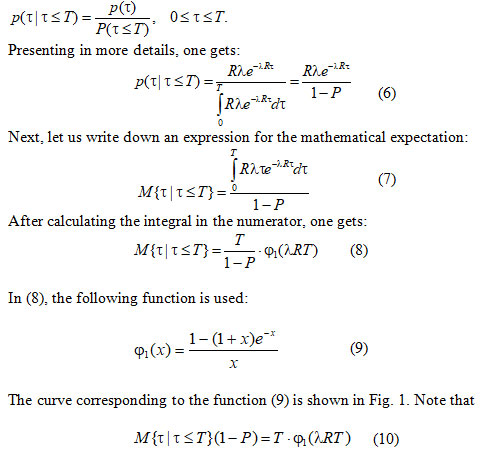
Figure 1: Graphical representation of the φ_1 (x) function
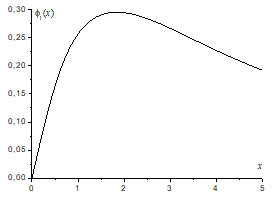
Now let us compose an expression for the mathematical expectation of the time needed for the system to reach the satisfactory state. Since the satisfactory state is reached during the period Tm with the probability.
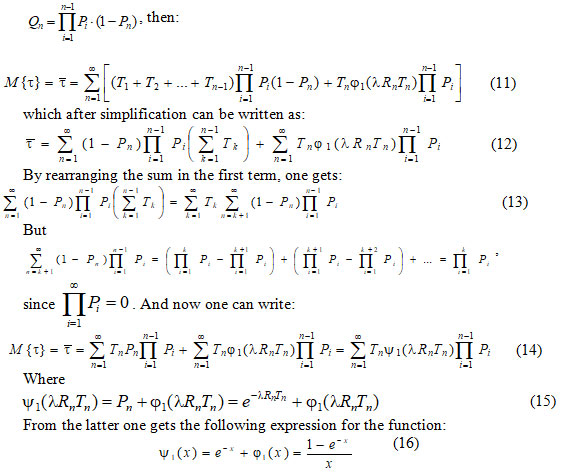
which can be used to calculate the average time needed by the system to reach the satisfactory state. A curve representing the average time needed to reach the satisfactory state is shown in Figure 2.
Figure 2: Plotted function for finding the average time needed to reach the satisfactory state by the irrigation system
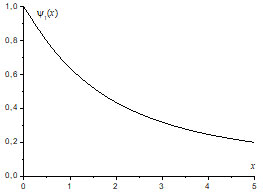
Thus, ultimately, the following expression is obtained:
 (16)
(16)
where it is believed that
![]()
Let us consider the optimization problem of reclamation activities at each phase. Let us compose an expression of the mathematical expectation of total income from the use of the agricultural landscape:
![]()
Here, Km is the loss, if the satisfactory state is reached at the n-th phase (Kitaeva and Stepanova, 2013).
The problem of optimizing φ based on {Sn} is reduced to solving the following system of equations:
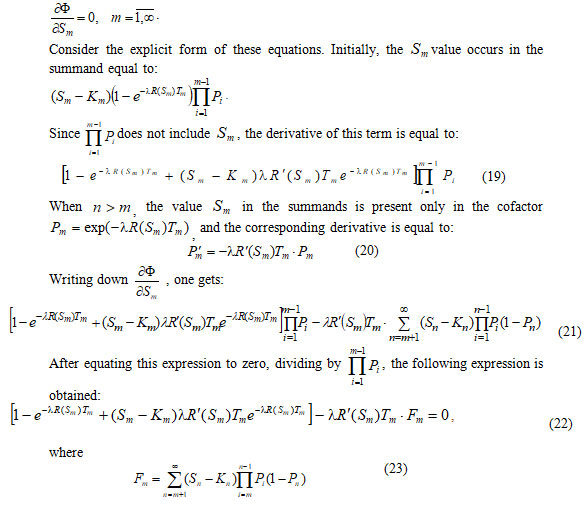
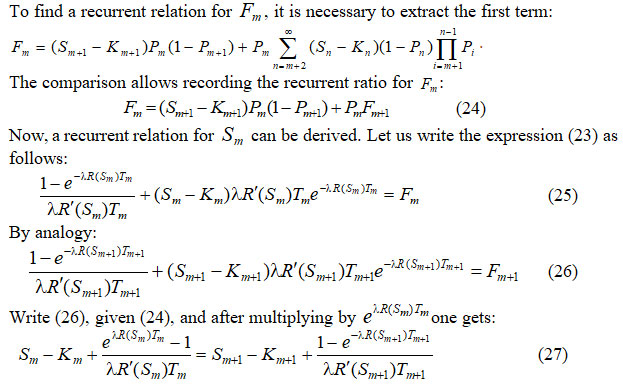

determined numerically (Ф – total income from the use of the agricultural landscape). The iterative planning process proposed in the work can be the basis of a program that corresponds to the optimal production activity, provided that the state of the external environment is maintained at a given level while choosing the optimal combination of various environmental protection measures that meet the requirements of environmental balance. When choosing a control action, the question often arises of replacing some control factors with others that have a similar effect on the transfer of the control object to a given state.
The outlined approach allows solving this problem and finding the optimal ratio of measures to prevent environmental damage. The considered concept of the price of sustainability of the agricultural landscape allows one to objectively choose the optimal solution for the use of resources. During the development of the project, several of its variants are compared. Different versions of the project may differ not only in technical parameters but also in the organizational and economic mechanism of implementation. Therefore, if we consider design as a process of developing the best version of the project, then it should also provide for the development of various options for the organizational and economic mechanism, the most rational of which will be accepted for implementation.
CONCLUSION
The authors have developed a mathematical (probabilistic) model of the irrigation system operation at a stepwise change in the scheduled event price. The model makes it possible to study the features of the system’s operation in any real situation, predict the system’s behavior when environmental conditions change, as well as reduce the risks of uncertainty when making managerial decisions. The optimization problem of finding the price change pattern of the satisfactory state of the system that would provide maximum profit taking into account losses from the unfavorable state, is considered. A recurrent ratio for total revenue is obtained, linking the scheduled activities at the m-th and (m+1)-th phases. This recurrent relation is used as follows. Having been given S0 , it is possible to find numerically S1, then, knowing S1, one can find S2, etc. As a result, a total revenue function can be obtained that depends only on S0. Next, examining the function concerning the extreme point, maximum profit is calculated numerically.
REFERENCES
Chebotarev, M.I., Prikhodko, I.A. (2013). Soil reclamation method in the fallow of rice crop rotation for rice sowing. Patent of the Russian Federation, 2471339C1. The applicant and patent holder: Kuban State Agrarian University, No. 2011124233/13, filed on 15.06.2011, published on 10.01.2013, Bulletin 1.
Degtyareva, O.G., Safronova, T.I., Rudchenko, I.I., Prikhodko, I.A. (2019). Nonlinearity account in the foundation soils when calculating the piled rafts of buildings and constructions. CATPID-2019 IOP Conf. Series: Materials Science and Engineering 698: 022015. https://doi.org/10.1088/1757-899X/698/2/022015
Dyachenko, N.P., Prikhodko, I.A. (2007). Optimization of resource provision of rice irrigation system. Bull. Kuban State Agric. Univ. 8:170-173.
Efrosinin, D., Farkhadov, M., Sztrik, J., Stepanova, N. (2018). Reliability analysis of an aging unit with a controllable repair facility activation. In:
Kitaeva, A.V., Stepanova, N.V. (2013). Linear on/off inventory control. In: Proceedings of the 15th International Conference on Applied Stochastic Models and Data Analysis (ASMDA2013), Mataro (Barcelona, Spain). Mataro: International Society for the Advancement of Science and Technology, pp. 497-504.
Kuznetsov, E.V., Safronova, T.I., Prikhodko, I.A. (2005). System-informational assessment of the ecological state of the rice irrigation system. Land Reclamation Water Manag.3:28-30.
Pilz, J., Rasch, D., Melas, V., Moder, K. (2015). Statistics and Simulation. IWS 2015. Springer Proceedings in Mathematics & Statistics, vol. 231. Cham: Springer. pp. 403-417.
Prikhodko, I. A., Verbitsky A.Y., Vladimirov, S.A., Safronova, T.I. (2020) Microflora microbiological characteristics of saline soils. E3S Web Conf. Volume 175, 09010. https://doi.org/10.1051/e3sconf/202017509010
Prikhodko, I. A., Vladimirov S.A. and Alexandrov D. A. (2021a). Application of ecologically balanced technologies of rice culti-vation in the Krasnodar Territory. E3S Web of Conferences Interagromash 2021, 273, 01017 https://doi.org/10.1051/e3sconf/202127301017
Prikhodko, I. A., Vladimirov, S.A., Alexandrov D. A. (2021b). Improving the elements of organic farming in rice cultivation. ESCGAP 2020 IOP Conf. Series: Earth and Environmental Science 659: 012062. https://doi.org/10.1088/1755-1315/659/1/012062
Safronova, T. I., Degtyareva, O.G., Vladimirov, S.A., Prikhodko, I.A. (2018). Price Characteristics of the project to construct the precipitation runoff system regulation. Research Journal of Pharmaceutical, Biological and Chemical Sciences. 2018.
Safronova, T. I., Vladimirov, S.A., Prikhodko, I.A. (2021) Probabilistic approach to soil fertility conservation by mathematical modeling of technological processes and optimization of resource use. International science and technology conference Earth science. IOP Conf. Series: Earth and Environmental Science 666. 042063. https://doi.org/10.1088/1755-1315/666/4/042063
Safronova, T.I., Prikhodko, I.A. (2019a). Mathematical Model of Ecological-Adaptive Meliorative Measures Selection. Fundamental Research, 9, 64-68.
Safronova, T.I., Prikhodko, I.A., Kantsur, D.A., Maslov, R.V. (2020a). Mathematical Model for Selecting Operating Measures on Rice Irrigation System. Puti povysheniya effektivnosti orashaemogo zemledeliya, 3(79), 131-137.
Safronova, T.I., Prikhodko, I.A., Kondratenko, L.N. (2019b). Analysis of The Estimation of Land Resources In Agriculture. Fundamental Research, 5, 110-114.
Safronova, T.I., Vladimirov, S.A., Prikhodko, I.A. (2020c). Probabilistic assessment of the role of the soil deg-radation main factors in Kuban rice fields. E3S Web Conf. Volume 175, 09011. https://doi.org/10.1051/e3sconf/202017509011
Safronova, T.I., Vladimirov, S.A., Prikhodko, I.A. and Sergeyev, A.E. (2020b). Optimization problem in mathematical modeling of technological processes of economic activity on rice irrigation systems. E3S Web of Conferences 210, ITSE-2020 05014. https://doi.org/10.1051/e3sconf/202021005014
Vladimirov S.A. and Alexandrov D. A. (2021). Transition to new technologies of rice cultivation in the Kras-nodar Territory. E3S Web of Conferences Interagromash 273, 01016. https://doi.org/10.1051/e3sconf/202127301016
Vladimirov, S. A., Safronova, T.I., Prikhodko, I.A. (2020a). A new generation rice card design for organic rice farming. CATPID-2020 IOP Conf. Series: Materials Science and Engineering 913. https://doi.org/10.1088/1757-899X/913/4/042008
Vladimirov, S.A. (2015). Criteria for productive use of land resources and sustainability of agricultural landscapes. In: Proceedings of the International science-to-practice conference dedicated to the 10th anniversary of the Institute of Land Management, Cadastre, and Soil Reclamation. Ulan-Ude: Buryat State Agricultural Academy named after V.R. Filippov, pp. 187-191.
Vladimirov, S.A., Prikhodko, I. A., Verbitsky A.Y. (2019a). Justification of rice watering methods and crop cultures. Journal of Agriculture and Environment. 1 (9). https://doi.org/10.23649/jae.2019.1.9.15
Vladimirov, S.A., Prikhodko, I.A. (2019b). Experience of Planning and Implementation of An Innovative Project of Effective Rice Growing. Mezhdunarodnyi Sel’skokhozyaistvennyi Zhurnal, 6, 75-79.
Vladimirov, S.A., Safronova, T.I., Prikhodko, I.A. (2019c) A probabilistic model of the process of land recla-mation management. International agricultural journal, 62 (4) 171-185. https://doi.org/10.24411/2588-0209-2019-10093
Vladimirov, S.A., Safronova, T.I., Prikhodko, I.A., Chebanova, E.F. (2020b). Water regime formation of river basins in the delta zone on the example of the Azov region. E3S Web Conf. Volume 175, 2020 XIII International Scientific and Practical Conference “State and Prospects for the Development of Agribusiness – Interagromash 2020”: 12010. https://doi.org/10.1051/e3sconf/202017512010.


